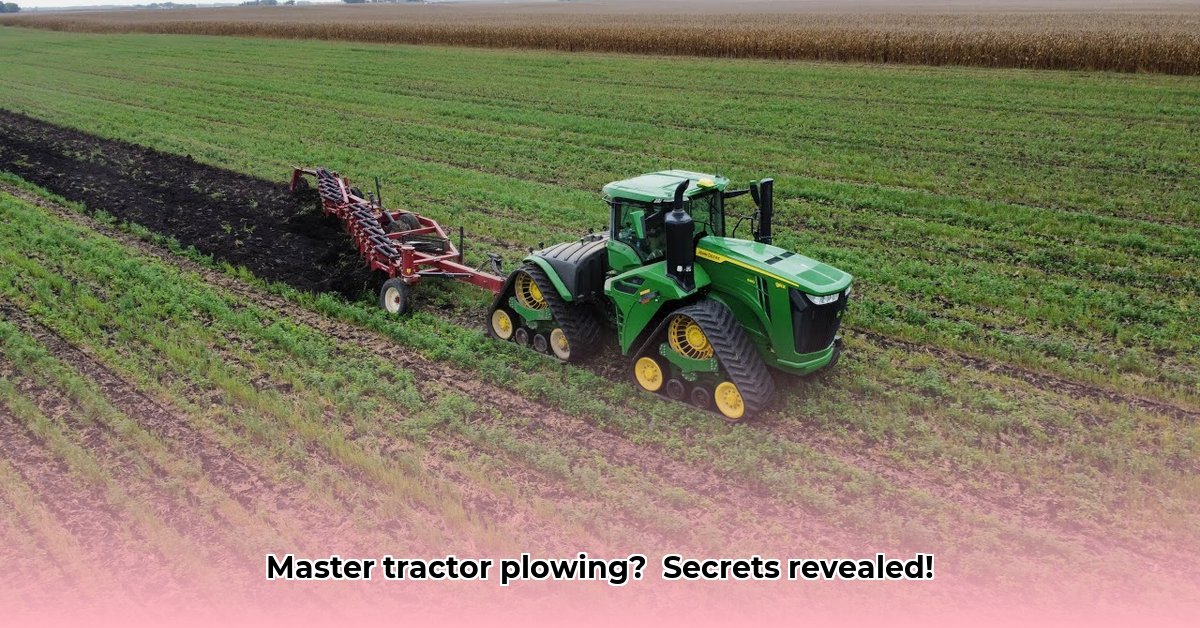
Getting Started: Pre-Plowing Preparations
Before you even think about firing up the tractor, thorough preparation is crucial for efficient and effective plowing. Think of it like a chef meticulously prepping ingredients before starting a gourmet meal – the better the prep, the better the outcome.
First, completely clear your field of any obstacles. Remove rocks, weeds, leftover crops, or anything that might damage your plow or clog it. This initial cleanup might feel painstaking, but it'll prevent costly repairs or frustrating delays later on. A clean field means a smooth plowing process.
Next, assess your soil moisture. Ideal soil moisture is crucial – too dry, and it'll be difficult to plow; too wet, and it'll compact beneath the plow. Aim for soil that's moist enough to turn easily but not so wet that it's sticky or muddy. This "Goldilocks" condition ensures optimal tilth (soil structure).
Finally, perform a comprehensive pre-operation check of your tractor and plow. This is akin to a pilot's pre-flight check – vital for safety and efficiency. Check your tractor’s oil, coolant, and tire pressure. Ensure your plow is securely attached and all parts are in good working order, paying particular attention to the sharpness of the blades. Preventative maintenance is your best defense against unexpected downtime.
Don't underestimate the importance of these preparatory steps. They lay the groundwork for a successful plowing operation and could save you significant time and frustration in the long run. Is there a better way to start your plowing project? For more information on tractor plows, check out this helpful resource.
Setting Up Your Tractor and Plow: Hitches and Adjustments
Attaching your plow to the tractor requires careful attention to detail. Consult your tractor and plow manuals; this isn't a step to improvise. Improper attachment can lead to serious equipment damage or even injury. Follow the manufacturer's instructions precisely.
The hitch adjustment is key to controlling plowing depth. This depth significantly influences how well the soil is turned and subsequently impacts crop yield. Begin by setting the hitch according to the manufacturer's recommendations. However, expect to fine-tune this setting throughout the process. The ideal depth depends on your soil type, its moisture content, and the type of crop you'll plant. You might need different settings across varying sections of your field. Remember, it is often an iterative process.
Mastering the Art of Plowing: Techniques for Success
Now, the actual plowing begins! Maintain a consistent, steady speed while plowing. Moving too quickly leads to uneven plowing; moving too slowly wastes time and fuel. Consistency is paramount. Slightly overlap each furrow to ensure complete soil coverage and prevent any missed areas. How can you ensure even and consistent depth throughout the entire process?
Keep a watchful eye on your work. Is your plow achieving the desired depth and width? Is the soil turning over cleanly or causing difficulties? If adjustments are needed, make them. The hitch, the depth wheel, or the top link can be modified to achieve optimal results. This takes practice. Finding the right rhythm comes with experience. Think of it like learning to ride a bike; you'll refine your skills over time.
Understanding Your Soil: How Different Soils React
Different soil types require different plowing approaches. Clay soil, for example, is heavy and sticky, often requiring a shallower depth and multiple passes. Sandy soil is much easier to manage and often allows for deeper plowing with fewer passes. Understanding your soil's unique characteristics is crucial for effective plowing. What considerations are there for different soil types?
Post-Plowing Tillage: Preparing the Seedbed
After the initial plowing, additional tillage is often necessary. Post-plowing tillage (harrowing or tilling) breaks up large clods and creates a smooth, level seedbed. This is crucial for successful seed germination and growth, increasing the likelihood of a bountiful harvest. How can you ensure a uniformly tilled seedbed?
Troubleshooting Common Problems
Even with careful preparation, challenges can arise. Here are some common issues and their solutions:
- Uneven Furrow Depth: Often indicates incorrect hitch settings, a misaligned depth wheel, or a faulty top link. Double-check and adjust as needed.
- Soil Not Turning Over Properly: The plow might need sharpening, your tractor may lack sufficient power for your soil type, or the soil might be too dry.
- Clogging: Rocks or debris can clog the plow. Regular cleaning and thorough pre-plowing field clearing are crucial.
Soil Type and Plowing Depth: A Quick Guide
This table provides recommended plowing depths for common soil types. Remember, these are guidelines; specific conditions may require adjustments.
| Soil Type | Recommended Plowing Depth (inches) | Notes |
|---|---|---|
| Sandy Loam | 6-8 | Generally easier to plow, less prone to compaction |
| Clay Loam | 4-6 | Requires more careful handling; deeper plowing can compact |
| Heavy Clay | 4-5 | Can be challenging to plow; multiple passes might be required |
Remember, this guide offers general advice. The optimal techniques depend on your equipment, soil type, and experience. Always prioritize safety. Take your time, be patient, and practice! Happy plowing!